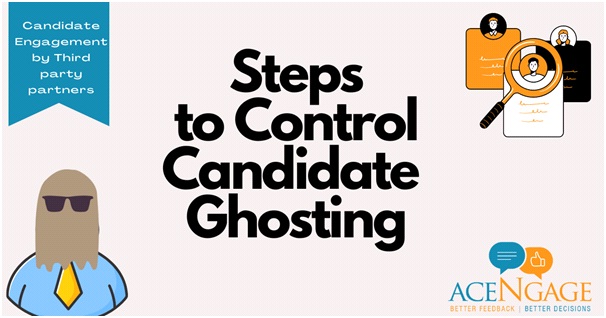[vc_row row_type=”row” text_align=”left”][vc_column][ultimate_spacer height=”20″][vc_column_text]When you least expect it, you are stood up- waiting. Sounds familiar? Haven’t we been there some time or the other? In the recruitment space, a lot more bells ring. Even after accepting the offer, recruiters are often stood up by candidates. Often referred to as ‘candidate ghosting’ or ‘no-shows’, it has been a regular phenomenon in the hiring process.
In 2022 alone, about 83% of companies have seen candidate ghosting. When a candidate fails to join the company, after offer acceptance then the candidate has ghosted. The risk of losing revenue and time is no longer a risk but an incurred loss at that pivoting moment when the candidate decides not to show up on the joining date.
So, when do you think is the risk of losing a candidate at its highest? It is in the time between offer acceptance and the joining date that the risk is at its highest. It is at this time that a candidate could get disengaged and lost, if not engaged. Or sometimes, candidates use the existing offer as a counteroffer, externally to get a better deal with other employers.
It is in this post-offer and pre-joining phase that candidates must be engaged with the most. It is, often, mistaken that a recruiter’s job is done after a candidate has signed the offer letter. But it is not.
Point is, extending an offer alone does not close the hiring loop.
Here are some of those ways to explore and what one must expect.[/vc_column_text][ultimate_spacer height=”20″][vc_row_inner][vc_column_inner][vc_column_text]
Expect the worst
- Expect and accept the fact that the worst could happen in a hiring cycle.
- Expecting beforehand keeps one better prepared for a rainy day.
- By having this mindset, recruiters can have a discerning eye to scan for signs from the start.
- Recruiters need to build stronger rapport with candidates. This means going a few layers below the resume, and understanding the candidate’s personality, life priorities, and the like.
- This exercise when done diligently gives a peak into what the candidate’s needs are.
- The same can be considered in the offer letter if possible, to the extent, the company policies are laid out. Every effort to hire and retain the candidate must be made.
- A mindset shift is required during recruitment. Rather than looking at an offer extension as a favour to prospective candidates, it must be viewed as ‘employers need the right employees.
[/vc_column_text][/vc_column_inner][/vc_row_inner][ultimate_spacer height=”20″][vc_row_inner][vc_column_inner][vc_column_text]
Create a hook
In the hierarchy of needs, compensation fulfills the basic sense of financial security. Recruiters must aim higher during every interaction with the potential candidate. Aspects such as growth, more opportunities, improved status in teams, etc, can be often shared as USPs with candidates.
This is not to say the candidate is bribed or over-promised even before assessing the actual performance. But it is to say and create a touchpoint, that will give more reasons for the candidate to stay longer, explore and reap more benefits from the company’s association.
We have seen that compensation is no longer a key deal breaker. As per research, employees are willing to take a pay cut to continue to enjoy extended flexible benefits. While some scenarios are not predictable and cannot always be avoided, here are some recommendations to share with the candidate to-
[/vc_column_text][vc_column_text]
Few Parameters to highlight-
- Total rewards and benefits
- A winning compensation structure
- Prospective Onsite opportunities
- Career growth paths and plans one can opt for, progressively
- Scope for cross-deployment and exposure to other sub-businesses and clients
- A fair system of appraisals and related bonuses
- Family-oriented well-being plans and programs the candidate’s family can enjoy
[/vc_column_text][ultimate_spacer height=”20″][/vc_column_inner][/vc_row_inner][vc_row_inner][vc_column_inner][vc_column_text]
What needs to be continued during the recruitment process
- The clarity in the process to improve candidate experience, minimize confusion
- Include branding in every interaction. Serve it as a reminder to the candidate as to how he/she will be part of the brand personality
- Involve the candidate and tie up onboarding actions to keep engagement on
- Have regular touchpoints, strategic and structured as part of rapport-building and hiring formalities to cement candidature
- Assign an onboarding buddy till the joining date
- Implement formal candidate engagement programs that the candidate can partake in, externally. This can be done by maintaining data privacy and confidentiality.
- Take regular feedback from candidates on all phases of the hiring process during or, even if they back out. Show that the company culture is invested in every interaction and that every candidate is important. This goes beyond compensation as a sole factor in decision-making for candidates.
- Stay competitive on what is in offer. Recruiters need to be aware of the compensation parity, lest the potential candidate may slip through to competition.
[/vc_column_text][ultimate_spacer height=”20″][/vc_column_inner][/vc_row_inner][vc_row_inner][vc_column_inner][vc_column_text]
- If the company policies do not permit selected candidates to engage in activities within, then third-party engagement partners can be signed up for.
- Third-party partners such as Acengage can maintain regular touchpoints with candidates until the date of joining. Have important conversations, take feedback, resolve queries and act as a bridge between the company and the candidate.
- The benefit of this approach is-
- The recruiters will not have the burden of handholding the candidate, amidst a zillion other responsibilities they have.
- Candidate engagement can be done, exclusively and maintain a laser focus on critical discussions with candidates.
- Third-party partners can blend in and represent the company’s values, without giving any perception to the candidate of being left out or neglected.
- Acengage can gather crucial points and observations during candidate interactions and share them with recruiters. This will help recruiters take the necessary steps to address the concerns of the candidates.
- Third-party connections can capture signs of disengagement for fixing them, on time.
[/vc_column_text][ultimate_spacer height=”20″][/vc_column_inner][/vc_row_inner][vc_row_inner][vc_column_inner][vc_column_text]
On a closing note
Many a time, the selected candidates fail to show up on the joining date, despite having all the answers. This could be a clear case that the candidate is not worth any further investment of time or money. It could also, be a case of someone just looking for a job and not a long-term career or an experience of work culture. However, there could be instances when the candidate could not communicate delays in joining. We need to cut the candidate some slack by contacting and understanding the situation. In other words, give the benefit of doubt to the candidate, in case there was a genuine problem that was the reason for the no-show. It is always advisable to follow up and confirm the status to reschedule joining dates.
Candidates have the choice of employers served on a platter. With talent being in demand, employers must take non-conventional and non-stereotypical approaches to hire and retain the best candidate. The culture and experience of an organization are like the glue that keeps candidates or employees stick for longer. Unintentionally, processes and systems often skip the glue and conclude that processes alone are sufficient. This would have worked in the past but not any longer. Recruitment experience goes beyond just interviews or compensation. Depending on the volume of candidate ghosting data, more interventions may be needed to analyse and adapt.
[/vc_column_text][ultimate_spacer height=”20″][ultimate_spacer height=”20″][/vc_column_inner][/vc_row_inner][vc_row_inner][vc_column_inner width=”1/2″][vc_column_text]
[/vc_column_text][/vc_column_inner][vc_column_inner width=”1/2″][vc_column_text]
[/vc_column_text][/vc_column_inner][/vc_row_inner][ultimate_spacer height=”40″][/vc_column][/vc_row]






